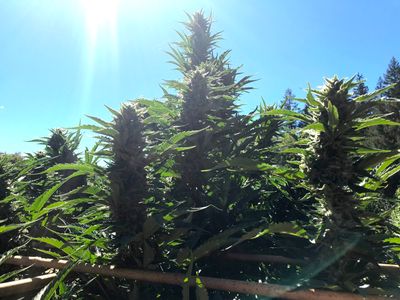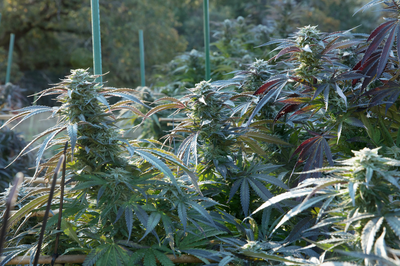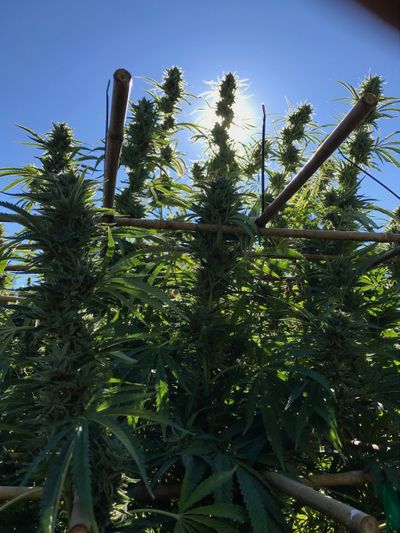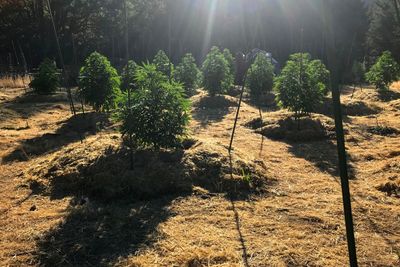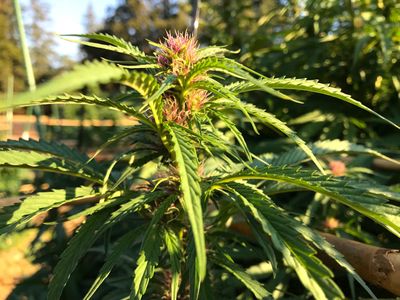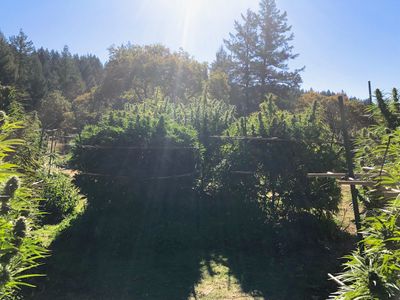All copyrights belong to Swami Select
Recently, a friend posed a couple of questions which a lot of people are asking, “Why choose sungrown cannabis? Why choose organic?”
The most concise answer: “Because it’s simply better. It’s cheaper to buy right now, too. And, it’s organic, so it tastes and smells better. It’s also better for the health of the consumer, and it’s better for the health of the planet.”
For the complete answer, however, you’re going to have to read the rest of this very lengthy essay. To begin, I recognize that a lot of people really like their indoor weed, and there are many places where, at the moment, that’s all you can get. So carry on.
Also, there are those in the medical profession who maintain that for cannabis to truly be medicine, it must be grown in a strictly controlled environment, such as a hermetically sealed container or cultured in a lab with yeast or bacteria, in order to guarantee chemical replicability and consistency. One can’t really argue with these folks, but if you do have a choice between indoor and organic sungrown, what really is the difference, and why?
When I first started to write about this subject, I must admit that I really knew nothing at all about indoor cannabis. I almost never knowingly smoke it. I have never grown it and have visited very few indoor grow rooms. In order to write this article, then, I interrogated a few friends at length who have grown indoor cannabis in the past and now grow organically in the sun. Much of what follows comes from their experiences. Also contributing to my understanding was a conversation at our ranch with two young travelers who had recently left jobs at an out-of-state, legal indoor cannabis factory.
A lot of indoor growers I meet say they really wish they could grow outdoors, but the economics are such that they just can’t make the move. In addition, as cannabis laws are crafted, many counties, states, and nations are only allowing indoor growing or are considering prohibiting outdoor cultivation. Their reasoning is that it is easier to control indoor grow sites and confine them to an industrial warehouse zone, as well as monitor the crops for potential theft and diversion to the illicit market.
Remember, the reason indoor pot growing started in the first place is that too many people up in the Emerald Triangle, the Santa Cruz Mountains, and the Sierra Foothills were getting arrested for growing under the bushes or in the trees. In the mountains, they responded by setting up grow lights powered by generators in shipping containers, rented houses, and hastily-built sheds. In the towns, cities, and college campuses, enterprising youth put mini-grows in closets, basements, and attics. It was not about growing the best weed; it was about not getting caught, but still having something to smoke.
Coincidentally, as I was pondering this question recently, I had a visit from Kyle Kushman, a renowned indoor grower and founder of the grow supply company Vegamatrix who is working on a new project and wanted to talk shop. For many years, he told me, he had grown in closets before moving to basements in the summer and attics in the winter. He stopped growing in attics when he happened to look up at his roof after a heavy snowstorm and realized his was the only one clear of snow, while all the other roofs had a foot of white — a dead giveaway of the grow, if anybody was looking.
Right off the bat, he said, “Indoor and sungrown are completely different animals.” I thought this was a curious word choice, given that Kyle’s company, Vegamatrix, offers a veganic line of microbial inoculants for cannabis cultivators. Then I remembered that, many years ago, Rick Pfrommer, when he was a judge at the Emerald Cup, stated pretty much the same thing. Which is to say, the two products are so different that it is difficult to compare them, and one should not expect the same effects from sungrown cannabis that they’d experience with indoor plants.
On the first level, many people are of the opinion that if something costs more it is necessarily better. Simply put, indoor is more expensive because the set-up costs to convert an empty warehouse into a grow facility are significant. Specialty grow lights, ventilation systems with industrial-size air conditioners, and water filtration equipment are expensive. Most importantly, indoors grows require costly electric lights while the sun grower gets daylight for free from on high.
Growing anything in a warehouse comes with a high overhead, including rent, utilities, garbage removal, and on and on. Monthly expenses add up very quickly. The carbon footprint is enormous from the electricity used for high-intensity lights, air conditioning, fans, heaters, dehumidifiers, water purifiers, and security equipment. Thus, a good percentage of the higher price for an indoor eighth of flower goes to pay for building renovation, capital investment in equipment, as well as monthly rent and utilities.
It is revealing to compare the carbon footprint of a small artisanal, organic outdoor farmer living on their land, to an indoor cultivation site in the warehouse district. Most of the legacy organic farmers I know are off the grid. They have solar panels to provide their power needs for both domestic and commercial use, which are backed up by small generators on darker days. They only use fans and dehumidifiers for six to eight weeks during the harvesting and drying season in the fall. Their power needs and the equipment required for the actual growing are minimal because the sun, the wind, and the weather are doing the work.
On the other hand, indoor water and electric bills are large because, in addition to lights and ventilation costs, hydroponic grows require fresh water for each new crop. This can be mitigated by installing expensive water purification equipment to recycle the water. Because this uses even more electricity, to lower these costs, savvy indoor growers reduce their carbon footprint by covering their roofs with solar panels. But that is another large capital expense, so few installations actually employ solar power.
In addition, the waste water from hydroponic crops can contain heavy metals and high salt concentrations (depending on what kind of fertilizer program is used), which need filtration and electricity, so they don’t contaminate local sewer systems.
To be fully compliant, all legal sungrown cannabis farmers are inspected and monitored by the State Water Resource Control Board and by the Department of Fish and Wildlife for their environmental footprint, and are allotted a specific volume of water to use for cannabis cultivation. Their wastewater practices and fertilizer use are also monitored annually by the State Water Quality Control Board. Outdoor farmers generally use organic soil inputs and compost teas, which are beneficial to the garden and do not drain into the watershed. So the environmental impact is minimal.
Many indoor growers who plant in soil discard that soil and buy it fresh again for every crop, as often as three times a year. Where do they dispose of this discarded soil? Is it contaminated with pests, pathogens, or heavy metals? Mindful sungrown farmers take years to “grow” their soil, by adding organic amendments to increase fertility and nourish the microorganisms living in the soil. While I do know of a few conscientious companies that grow indoors in “living soil,” it is not at all easy, so very few practice this art.
Be that as it may, a high percentage of “factory” growers use bottled nutrients straight off the shelf, which are primarily made from petrochemicals. The leftover salt residues that the plant was unable to absorb are flushed out at the end of the grow cycle and go into waste water if they are not filtered out. Some phosphate fertilizers contain polonium-210, which is radioactive. Many bottle fertilizers contain EDTA, a synthetic chelating agent used to promote nutrient absorption, but it actually damages the plants’ living rhizosphere — the region of soil around a plant's roots, which contains nutrients and beneficial microorganisms — and is harmful to humans.
Cannabis plants are known as “phyto-remediators,” meaning their root systems pull poisons and contaminates up out of the soil, as well as nutrients. Whatever is in the soil or in the hydroponic system will be brought up into the flower. This may not show up when the flowers are tested, but often will be detected in certain concentrates, because the contaminants are also concentrated in those products.
To be fair, there certainly are outdoor growers who, for the sake of convenience, use non-organic fertilizers and pesticides in bottles off the shelf. One can only hope that they also up their game and begin to employ best practices and evolve toward organic, regenerative methods. This applies to those intrepid farmers still operating in the traditional market, or the so-called “black market,” as well as those brave few who entered the new legal market. The advantage, nowadays, of buying your cannabis at a licensed retailer is that it has to be tested for pathogens, pesticides, and potency before the retailer can sell it.
The most conscientious organic outdoor cultivators do not use bottled petro-chemicals. Rather, they brew organic teas, use worm castings, animal or green manure, organic straw mulches, alfalfa meal, sea kelp, cottonseed meal, green sand, rock phosphate, or gypsum. They plant cover crops of clover, vetch, various beans, sweet pea, etc. all to feed and regenerate the soil. The living soil, full of microorganisms, transforms the nutrients naturally in the earth to make them available to the plant. The farmer feeds the soil — the soil feeds the plant. As a result, the soil does not need to be flushed before harvest, saving water and pollution. All of these natural ingredients are much cheaper than the branded formulas on the shelves of the garden supply store. Wouldn’t you rather smoke or ingest a plant grown in the above menu of organic and mineral ingredients, than one grown in a factory, with expensive petro-chemicals out of a plastic bottle?
This brings up another issue — indoor growing is “mono-cropping,” which sooner or later can create a serious pathogen or pest problem. An indoor grow is often even more narrow genetically, sort of a mono-pheno-type crop, because typically a cultivator will clone only one or two different cultivars to grow hundreds or thousands of plants. Ideally, they want a sterile, controlled environment with no pests or pathogens at all. Sometimes, commercially-obtained clones are contaminated with pests or pathogens or even pesticides. As a result, when pests or pathogens inevitably arrive, they have no predators to attack them or other crops to feast on, so the invader can wipe out the whole grow and infect the entire building. To adapt to the indoor environment, new mutations create superbugs and pesticide-resistant strains of mold and mildew.
Sungrown cannabis, when grown using organic methods, is not a mono crop. Most organic farmers also have a vegetable garden, use companion planting as well as cover crops, and the surrounding nature is abundant with trees, weeds, flowers, animals, and insects. Farmers who grow from seed have greater variation in their crops, but there is not the risk of importing contamination that can come with commercial clones.
To deal with pests and pathogens, the outdoor organic farmer employs integrated pest management. This is a program that uses targeted predator insects to manage the pests; companion planting to attract pests to their favorite foods; and introduces beneficial fungi, bacteria, and nematodes to create living soil via compost teas, which keeps pests and pathogens in balance, without pesticides.
To stimulate plant growth indoors, many cultivators spray carbon dioxide gas over the plants. Naturally, some of the gas is not absorbed by the plants and so escapes into the atmosphere. This and other practices can create hazardous conditions for employees. Workers are often in the grow rooms when carbon dioxide is sprayed — they can hear the hiss of the gas. The workers are not supposed to be in the room for more than four hours or they can pass out. If sulfur smoke is sometimes used to control mold and mildew, how are the workers protected? Many indoor garden workers and indoor flower trimmers report skin rashes and respiratory problems. Plus, having to work long hours indoors under harsh lights in a sterile and markedly mechanistic environment is not conducive to joyful employment.
Compare this to the workers at an organic outdoor cultivation site, surrounded by trees, flowers, and vegetables, listening to the singing of the birds and the buzzing of the bees. The sun is shining, a gentle breeze blows, a raven floats overhead, the wild turkeys roam the meadow they share with us and the deer. The dark and moonlit nights are cool, the days of August blazing hot.
The sungrown plants are part of the natural cycle of oxygen/CO2 interaction happening in the plant. Research indicates that the oxygen produced by the plant using sunlight during the day comes from the breakdown of the H2O water molecule. The plant uses the energy from that reaction to break apart the CO2 molecule from the air to make sugars in the plant, which it exudes out its roots to feed the bacteria and fungi living in the soil, in what is known as the rhizosphere.
Since the indoor plant is not using sunlight, can it produce as much oxygen? And if you are adding extra CO2, then clearly the plant is not helping to remove CO2 from the surrounding air, which the plants do outdoors.
At the most fundamental level, there is a quantum difference between using electric lights inside a factory to grow cannabis hydroponically in artificial environments, versus putting plants in living soil to grow organically in the sun out in nature. For indoor plants, the growth cycle is most often about three months from clone to harvest. For sungrown plants started from seed, the season is about seven months or longer, depending on the cultivar.
The newest, most expensive high-tech indoor lighting systems vainly seek to mimic the qualities of sunlight, the latter which changes angle, intensity, and color temperature throughout the day, as well as from day-to-day throughout the long grow season. Even the best light bulbs cannot match the unique qualities and power of sunlight, which also radiates forms of energy on both sides of the visible spectrum. Clearly, a plant which has been energized by the sun for more than 200 days is going to have more vitality and develop more fully than a 90-day indoor plant grown under artificial light.
So why not use the sun? It’s free! It has no carbon footprint! Further, sungrown plants are energized by the moon, the stars, the wind, and the rain. With an indoor grow, great effort and expense is spent to overcome or control the environment, whereas the organic sungrown plant becomes an expression of its environment through the microbiome of the living soil’s food web that supports its growth, and the macrobiome of everything living in its neighborhood.
On the retail level for the consumer, another apparent justification for the higher price of indoor cannabis is that it has more bling or sparkle, and it often has much higher THC content than outdoor-grown weed. The dazzling display of “crystal” has shelf appeal, as they say, and many smokers just want the highest THC — the old “bang for your buck” theory. But does that mean it’s better or even stonier? Well, that depends on what you mean by better and by being stoned or high.
Over the 15 years that Nikki and I have been judging flower at the Emerald Cup, we’ve noticed a few patterns emerge. Even though this is an organic sungrown cannabis competition, we have seen entries which are covered in “pavé” crystals (a French word which means paved with tiny glistening diamonds), which almost look like indoor grown weed. But those buds and their shiny trichomes are never the 1st Place winners. This may be because there are six types of trichomes and the pavé is only the biggest, most obvious kind. Yet the other varieties bring depth and complexity to the effects. While judging, I look at each bud with a 60x mini-scope to check out the different kinds of trichomes and to see what percentage are cloudy, clear, or amber. But in reality, a winning entry always comes down to the terpenes and the effects of the full ensemble of active compounds activated when the flower is smoked.
Once the Emerald Cup began to test the flower entries for potency, it became clear that the winner was never the cultivar with the highest THC. Often, 1st Place came in at 17 or 18 percent THC. What set the Top 20 winners apart was always the terpenes, the fragrance of the flower — the enchanting, arresting aromas which define the numerous varieties of cannabis while creating the subtle, more complicated highs. These and all the 500-plus constituent compounds in the cannabis produce the ensemble effect, also known as the entourage effect, creating a truly memorable high.
Typically, indoor cannabis has fewer and less potent terpene content. Scientists indicate that terpene production is primarily stimulated by threats to the plant. To protect itself from disease and to drive away predators and attract benefactors, the plant produces terpenes at night, which it then off-gasses all day long as volatile organic compounds. Different geographic locations generate different environmental threats, which, along with locally sourced nutrients, as well as native soil and water, produce different terpenes in response.
A sterile, controlled environment indoors does not present the variety or intensity of threats the plant must face outdoors. There is a theory among the old-time growers that you have to torture your plants a little bit to make them more potent. When threatened, the plant responds by producing terpenes and cannabinoids to protect itself. Additionally, for an indoor grow, the city water is purified, or it may contain chlorine or fluoride, and the nutrients come out of a bottle. This artificial uniformity and lack of existential threats to the plant may be why indoor cultivation produces fewer terpenes.
In addition, with the extra-high concentrations of THC produced when cannabis is grown indoors, all the other ingredients which broaden and deepen the consumption experience are reduced. The result is a high which comes on faster but the fall-off is quicker. There is not that “creeper high” that comes on slow but lasts a while. With over 530 different compounds in a cannabis plant, the quality and the experience for the consumer revolves around the interaction of all the cannabinoids and constituents in the plant. This creates a unique ensemble which expresses the individual ratios within each cultivar, balancing and augmenting each other.
At this point, I am sure many indoor growers are saying, “What the heck. I grow the best weed of anybody!” Now, I am not saying that all indoor growers do all, some, or even any of the potentially harmful things listed above, or that Joey down the street, who grows in his attic, is using pesticides. There are many ethical indoor growers who strive to produce clean, high-quality cannabis. I’m also not saying you shouldn’t buy or use indoor cannabis, either. If it works for you, have at it!
But for your own health and safety, first and foremost, as an aware consumer you should ask these questions before you buy: where and how was the cannabis grown — was it indoors or in the sun? Was it in soil, or hydroponic, in the ground, or in a pot? Is it organic? Were any pesticides used? What kind of nutrients were used? What was the carbon footprint? Essentially, is the flower clean and pure? For me, I only want to smoke pesticide-free, sungrown, organic cannabis grown from seed in the living soil of the earth for the long season.
Once the location and method of cultivation is verified, to understand how a particular product will affect you, the discriminating connoisseur needs to know the THC, CBD, and any other cannabinoid percentages and ratios that are reported. But perhaps most important for understanding the effects of their favorite cannabis product, the concerned cannabis consumer needs to know the terpene profile. But that is a whole other story, for another day.
Further, those consumers who are concerned about the environment and their personal carbon footprint will want to look closer at the practices of their cannabis cultivator and manufacturer — whether indoor or sungrown — to see if they are striving towards sustainability and being environmentally friendly. If you only eat organic bananas and heirloom tomatoes, you certainly want to make sure you are only consuming sungrown, organic, pesticide-free cannabis.
So what is it that truly sets sungrown cannabis apart? In essence it comes down to sun, soil, and farmer. This is called the terroir, another French word, which refers to the environment, as well as the soil, and to the traditional culture of the farmers who grow the plant. Cannabis grown organically, in the ground, in the full sun, for the full season becomes, after curing, a true expression of the locale in which it originates. Cannabis grown indoors in a uniform and controlled environment with off-the-shelf inputs will be a standardized commodity.
Ask yourself, “Would you drink indoor wine?” “Would you smoke a Cuban cigar grown in a warehouse?” If all tobacco grown indoors tasted the same no matter where it came from, there would be no such thing as a Cuban cigar. If all wine tasted the same, no matter what year, or no matter where or how it was grown, the mystique would be gone. We look forward to and celebrate the differences expressed in each vintage and brand, as well as in each different varietal and vineyard. Just so, we look forward to the unique cultivars and terpene profiles each new cannabis harvest brings.
So if you want the true experience of cannabis the way it has been grown and used for thousands of years, with the balance of all its hundreds of magical compounds, each in a unique ratio to the whole, and if you truly care about the environment, please enjoy sungrown organic cannabis and whole plant medicine derived from these flowers. Sungrown cannabis smells better, tastes better, and it provides a deeper, more complex, fuller, and longer-lasting high. It’s cheaper (for the moment), it’s cleaner, and it’s way better for the environment. What’s not to like?
For more on Swami Select, visit their website here and follow them on Instagram
